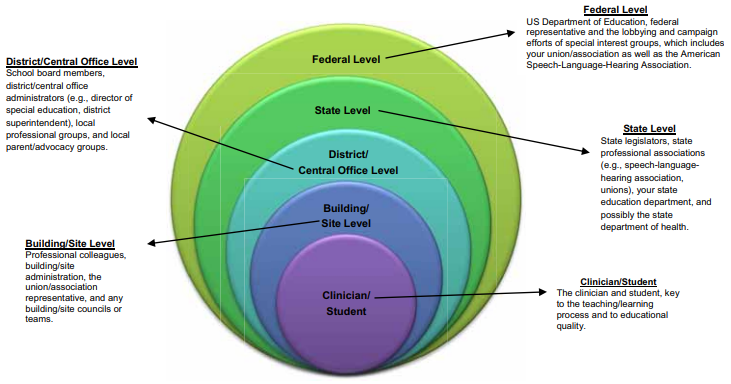Understanding the Decision-Making System
Working for Change: A Guide for Audiologists and Speech-Language Pathologists in Schools
School-based audiologists and SLPs may feel disappointed and frustrated when their needs are overlooked at the local level—primarily due to their relatively small representation within the membership. Experienced professionals in negotiations and decision making will tell you that achieving action and results is directly related to your ability to influence decision makers within the system. You can achieve this by representing your needs through union involvement and engaging in negotiations and collaboration with other stakeholders.
An effective system is one that meets the needs of all constituents. For this to happen, all parties must advocate for their unique interests—only that will truly drive change. Such advocacy includes actions taken by audiologists and SLPs.
The graphic below illustrates the various levels at which decisions are made.

Clinician and Student Level
At the center of the above figure is the clinician–student partnership, whose professional relationship is fundamental to the teaching and learning process and the quality of education. The support provided by the surrounding outer circles is crucial for ensuring that the student gets connected with a qualified clinician and has a positive learning experience. Decisions made in these outer circles significantly influence the success of both the teacher and clinician. The interactions between the inner circle and the outer circles are essential in shaping decisions that are beneficial to all.
Building or Site Level
This level encompasses professional colleagues, building or site administration, union or association representatives, and any building or site councils or teams. You and your colleagues’ collective efforts can influence many decisions that are made at the building or site level. One essential way that you can effectively impact these decisions is to build strong relationships with the other key players at this level.
District or Central Office Level
Decision making at the district or central office level involves school board members; district or central office administrators (e.g., director of special education, district superintendent); local professional groups; and local parent or advocacy groups. Your influence at this level depends on (a) your active participation in the union or association and (b) your relationship with the district or central office administration.
State Level
Decision making at this level involves state legislators; state professional associations (e.g., state speech-language-hearing associations and unions); the state education department; and, potentially, the state department of health.
Federal Level
This level involves legislation passed by Congress and regulatory guidelines established by the U.S. Department of Education. Key players include your federal representatives as well as the lobbying and campaign efforts of special interest groups, such as your union or association and your national organization—in this case, ASHA.
It’s helpful to know that decision making around aspects of employment are made at different levels. For example:
- Administrators at the building or site level typically determine scheduling.
- The district or central office typically decides on staffing assignments.
- The school board (located within the district or central office) usually sets salary scales and workday length.
In some cases, decisions that influence a specific issue are made at multiple levels. For instance, these factors (or a combination thereof) may impact caseload size:
- How students are scheduled occurs at the building or site level.
- The number of SLPs assigned to a particular building is determined at the district or central level.
- The number of SLPs hired throughout the district is determined at the school board level.
- Guidelines or mandates regarding caseload size and workload analysis occur at the state level.
Understanding how and where decisions are made is crucial to effectively navigating your school system and influencing decision makers. It’s also important to remember the interaction at various levels. Union or association officers can play a vital role in bridging these levels through their structure, providing information to each level from the union’s or education association’s parallel structure.









